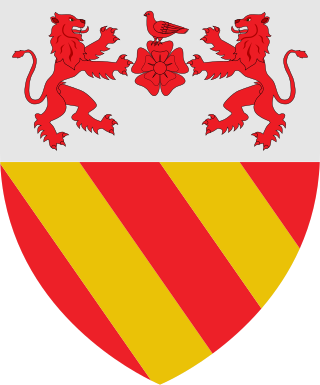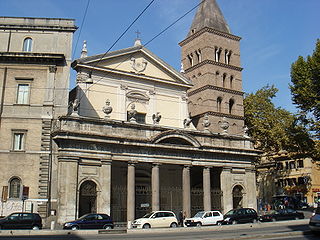Related Research Articles

Matilda of Tuscany, also referred to as la Gran Contessa, was a member of the House of Canossa in the second half of the eleventh century. Matilda was one of the most important governing figures of the Italian Middle Ages. She reigned in a period of constant battles, political intrigues and Roman Catholic excommunications, and was able to demonstrate an innate and skilled strategic leadership capacity in both military and diplomatic matters.

Pope Gregory VII, born Hildebrand of Sovana, was head of the Catholic Church and ruler of the Papal States from 22 April 1073 to his death in 1085. He is venerated as a saint in the Catholic Church.

Pope Nicholas III, born Giovanni Gaetano Orsini, was head of the Catholic Church and ruler of the Papal States from 25 November 1277 to his death on 22 August 1280.

Lucca is a city and comune in Tuscany, Central Italy, on the Serchio River, in a fertile plain near the Ligurian Sea. The city has a population of about 89,000, while its province has a population of 383,957.
Pope Damasus II was the Bishop of Rome and ruler of the Papal States from 17 July 1048 to his death on 9 August that same year. He was the second of the German pontiffs nominated by Emperor Henry III. A native of Bavaria, he was the third German to become pope and had one of the shortest papal reigns.
Anacletus II, born Pietro Pierleoni, was an antipope who ruled in opposition to Pope Innocent II from 1130 until his death in 1138. After the death of Pope Honorius II, the college of cardinals was divided over his successor. Unusually, the election was entrusted to eight cardinals, who elected Papareschi. A larger body of cardinals then elected Pierleoni, which led to a major schism in the Roman Catholic Church. Anacletus had the support of most Romans, including the Frangipani family, and Innocent was forced to flee to France. North of the Alps, Innocent gained the crucial support of the major religious orders, in particular Bernard of Clairvaux's Cistercians, the Abbot of Cluny Peter the Venerable; and Norbert of Xanten, the Archbishop of Magdeburg who established the Premonstratensians and held a high rank in the court of the German Emperor Lothar III.
Gregory VIII, born Mauritius Burdinus, was antipope from 10 March 1118 until 22 April 1121.

Anselm of Lucca, born Anselm of Baggio, was a medieval bishop of Lucca in Italy and a prominent figure in the Investiture Controversy amid the fighting in central Italy between Matilda, countess of Tuscany, and Emperor Henry IV. His uncle Anselm preceded him as bishop of Lucca before being elected to the papacy as Pope Alexander II and so he is sometimes distinguished as Anselm the Younger or Anselm II.

The House of Savelli were a rich and influential Roman aristocratic family who rose to prominence in the 13th century, and which included several popes, senators and condottieri.

San Crisogono is a church in Rome dedicated to the martyr Saint Chrysogonus. It was one of the tituli, the first parish churches of Rome, and was probably built in the 4th century under Pope Sylvester I (314–335).

The 1061 papal election was held on 30 September 1061 in San Pietro in Vincoli in Rome, following the death of Pope Nicholas II. In accordance with Nicholas II's bull, In Nomine Domini, the cardinal bishops were the sole electors of the pope for the first time in the history of the Roman Catholic Church. Bishop Anselmo de Baggio of Lucca, a non-cardinal and one of the founders of the Pataria, was elected Pope Alexander II and crowned at nightfall on 1 October 1061 in San Pietro in Vincoli Basilica because opposition to the election made a coronation in St. Peter's Basilica impossible.

The Archdiocese of Lucca is a Latin Church ecclesiastical territory or diocese of the Catholic Church in Italy. The diocese dates back as a diocese to at least the 4th century; it became an archdiocese in 1726. The seat of the archbishop is in Lucca, in the cathedral of S. Martino. It is not a metropolitan see, has no suffragan dioceses, and is immediately subject (exempt) to the Holy See (Papacy).
John of Crema was an Italian papal legate and cardinal. He was a close supporter of Pope Callistus II.
Pietro Senex was Cardinal-Bishop of Porto from 1102 until his death. He was born probably in Rome.

The 1099 papal election following the death of Pope Urban II took place on 13 August 1099. Before his death, Urban had designated Cardinal Rainerius da Bieda as his successor. The cardinal-electors, with the consent of the lower Roman clergy, chose Rainerius, who, after a flight and over his considerable objections, accepted and took the name Paschal II. He was consecrated a bishop and crowned pope on the next day.

John Leonardi, OMD was an Italian Catholic priest and the founder of the Clerics Regular of the Mother of God of Lucca.
Events during the year 1113 in Italy.
Vitalis of Albano was a Cardinal and bishop of Albano.
Desiderius was a Roman Catholic Cardinal, and Cardinal-priest of the titulus of S. Prassede in Rome.
Gregorius was a 12th century Roman Catholic Cardinal, and Cardinal-priest of the titulus of San Lorenzo in Lucina in Rome. A remark by Hugh the Chanter of York appears to indicate that he was a native of Siena. Rudolf Hüls, however, notes that Hugh might have mistaken Gregory of San Lorenzo and Gregory of Santa Prisca. Alfonso Chacón (Ciaconius) calls him Gregorius de Ceccano, a Hernician of the diocese of Aquino. Lorenzo Cardella says that Gregorius was born in Ceccano in the diocese of Sora, "da nobilissima famiglia". There is no evidence whatever that Gregorius of San Lorenzo was a member of the Albergati family of Bologna.
References
- Horst, Uwe (1980). Die Kanonessammlung Polycarpus des Gregor von S. Grisogono (in German). München: Monumenta Germaniae Historica. ISBN 978-3-921575-98-7. OCLC 185920948.
- Hüls, Rudolf (1977). Kardinäle, Klerus und Kirchen Roms: 1049–1130 (in German). Bibliothek des Deutschen Historischen Instituts in Rom. ISBN 978-3-484-80071-7.